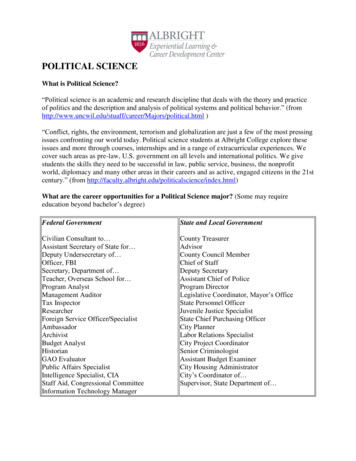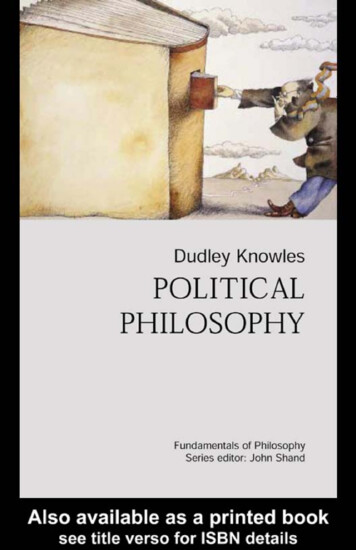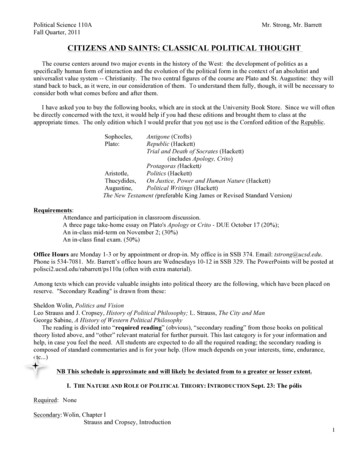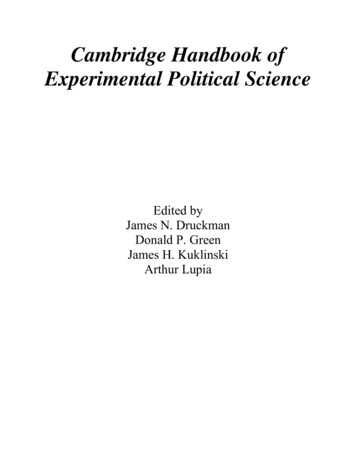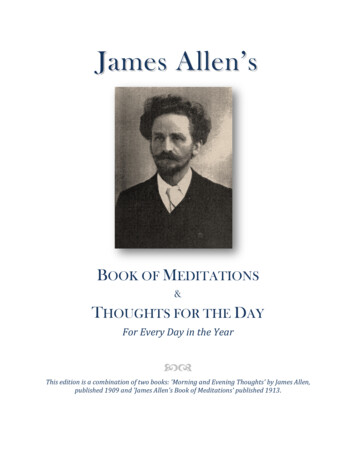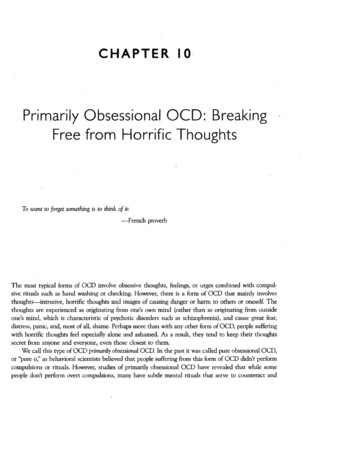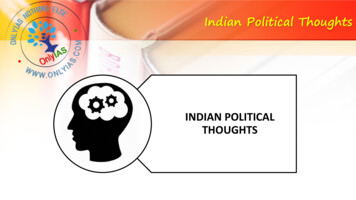
Transcription
Indian Political ThoughtsINDIAN POLITICALTHOUGHTS
Question Que. Why there is a debate with respect to the existence ofIndian political thought, do you think Indian political thoughtsexist, if yes what are the salient features of Indian thinking?
In western world there is little recogniation of Indianpolitical thinking. The common impression is that Indians lack politicalthinking. George Tanham categorically reject that Indians have“political Culture”.
It is believed that India is a place to look for spiritualknowledge and not political knowledge. Reason According to Western Scholars there are no text whichcan be called as Purely Political Text.
According to them even when we accept KautilyaArthashastra, it is more a text on Statecraft rather thanpolitical philosophy. However, it is wrong to suggest that Indian lack politicalthinking.
We can give reference to Edward said view of“Orientalism”. The lack of recognition of Indina thinking show the EthnoCentric attitude of the West.
Max Muller who is regarded as one ofthe greatest Indo Logist has acceptedthat no where in the world humanmind has dealt with various questionsof life with such a depth as they havebeen dealt in India.
India has been the source of enlightenment for the world.
Professor VR Mehta suggested thatthe failure to acknowledge Indianpolitical thinking is because of thedifference in perspective of East andWest.
In Western world people look things in dichotomousmanner. For example west have separated individual and Society,nature and culture, politics and ethics.
On the other hand Indian look in continuity. In India there is no separation is between individual andSociety, nature and culture, Dharma and Danda (Politics).
Moris Jones has acknowledged that neglect of Indianthinking would result into the impoverishment of the West.
SALIENT FEATURES OF INDIAN POLITICAL THINKING1. No separation in Dharma and Danda
SALIENT FEATURES OF INDIAN POLITICAL THINKING2. Communitarian Approach
SALIENT FEATURES OF INDIAN POLITICAL THINKING3. Pluralistic Tradition
SALIENT FEATURES OF INDIAN POLITICAL THINKING4. Cosmopolitan Worldview
SALIENT FEATURES OF INDIAN POLITICAL THINKING5. Non-Critical
SALIENT FEATURES OF INDIAN POLITICAL THINKING6. Pessimistic
SALIENT FEATURES OF INDIAN POLITICAL THINKING7. Regressive view of History rather than Progressive
Question Que. Discuss major political traditions in ancient India also givecomparative analysis of the tradition?.
Bhikhu Parekhclassified ancientIndian tradition intoTwo Categories1. Hindu Tradition2. Buddhist Tradition
According to Bhikhu Parekh,In India “we see continuity rather thanchange”.Hence there is not a big difference inHindu political tradition and Buddhist.
Buddhism can be considered as a Rebel child ofHinduism.
Though Buddhism challenge Brahmanic way of lifespecifically caste system. yet Buddhism shares many beliefs with Brahminism. For Example, Karma Theory of Rebirth.
Bhikhu Parekhcategorizes Hindutradition into twocategories1. Dharmashastra2. Danda Sahasra
Even Dharma Shastra and then the Danda Shastradiffer only in terms of degree rather than in terms ofkind. Dharmashastra are considered as book on laws(governing Hindu code of conduct), Danda shastra deal with politics and Statecraft. In ancient Indian politics used to be called as Dandneeti or Rajneeti.
In India we do not see clear separation betweenDharma and Danda In Danda Shastra, there is a discussion of Dharmaalong with Danda and similarly in Dharma Shastrathere is a discussion of Dharma and danda. The only difference is of the focus.
In the Dharma Shastra, discussion on Dharma is Coreand discussion of Danda is peripheral. Similarly in the Danda Shastra, discussion on theDanda is core and Dharma is peripheral.
Question Q. Discuss the salient ideas given in Manu smriti.
INTRODUCTION (MANUSMRITI) Manu smriti is a highly contested and controversialtext. One of the greatest admirer of Manu smriti was Dr SRadhakrishnan where as one of the major critique ofManusmriti was Ambedkar who suggested to putDynamite on Vedas and Manusmriti.
ManusmritiDr SRadhakrishnanAmbedkar
INTRODUCTION (MANUSMRITI) Manu smriti was also criticized by feminist scholarbecause of subordinate status given to women. According to Manu women should not be givenfreedom, but should be live under constantsurveillance of Men.
Manusmriti is considered asVedic text.Vedic text are categorizedinto two types.1. Shrutis2. Smritis
Shrutis are also known as Veda, Vedas are nothuman creation. It contains very revealedknowledge. Smritis are based on Vedas. one of the most wellknown Smriti is Manu smriti. Manu smriti is recognized by Britishers as basis forHindu personal laws.
WHO IS MANU? Manu is known as manasputra of Brahma (thecreator of universe).
WHY MANU WAS CREATED? There was ' arajakta' on the earth, matsyayanawas preveiling, hence people requested Brahmato bring them out of anarchy. Brahma created Manu.
WHY MANU WAS CREATED? Manu is the first King or law giver. Manu has told what is Dharma. Dharma has ended anarchy and establishedorder.
Question Que. Write short note on Indian concept of Dharma?
CONCEPT OF DHARMA There is no exact translation available in any of theEuropean language with respect to Sanskrit word Dharma,it should not be confused with English word religion.
CONCEPT OF DHARMA According to Rig Veda “Prithvi Dharmam Dhritam”. Dharma is which hold the life on the earth.
WHAT WILL HAPPEN IF WE DO NOT FOLLOW DHARMA? It will lead to Arajakta. It will lead to Pralay or end of the life on the earth.
SOURCES OF DHARMA? Rta(Riti)- Rta is cosmic law or the law of Universe. Hence Dharma has to be understood in harmony with thelaw of nature. Thus Rta is law governing universe or nature, Dharma is lawgoverning human society.
MANUSMRITI Talks about the role of the King. The role of the King is to maintain Dharma andthat's why King has Danda if the dharma is not maintained it will lead to theend of life on the earth.
PURUSHARTHA
FourPurushrthaDharmaArthaKamaMoksha
PurushArtha means “4 goals of life”. Unlike Buddhism which overlooks the material andphysical aspect of life, Hinduism takes a balanced view of life Hinduismtalks about the four goals- Dharma, Artha, KamaMoksha.
CONCEPT OF ASHRAM Manusmriti as well as other Indian text mention fourAshrams Brahmacharya, Grihasthya, Vanprastha, Sanyasa.
Manu smriti aswell as orderIndian textmention .
VARNAS Manusmriti discuss 4 Varna, it takes the reference ofpurushArtha of Rigveda. According to Manu the most important function ofthe King is to ensure that different Varna observetheir Varna Dharma. King is to punish those who do not observe theirvarna Dharma because it will lead to anarchy.
SANSKAR Hindu Text Mentions 16 Essential Rituals calledas Sanskar.
SanskarI Sanskar16 SanskarGarbhadanAnteyshti
MANUSMRITI ON STATE Origin of State (Quasi contractual theory) It is called Quasi contractual because thecontract is between people and God. people requested Brahma and Brahma createdthe State. Objective of State is to uphold Dharms.
Chapter 7 of Manusmriti deals with the State andInstitution of Kingship 1. People requested for God, God created King.
Chapter 7 of Manusmriti deals with the State andInstitution of Kingship 2. King has divine personality. Why 8 Gods have given a part of their personality tothe King (Indra, Varun, Yam, Kuber, Agni, Chandra,Surya, Wayu.
Chapter 7 of Manusmriti deals with the State andInstitution of Kingship 3. King has a divine personality but King does nothave divine Rights. Unlike west where King had absolute powers, inancient India even King was under the Dharma.
Chapter 7 of Manusmriti deals with the State andInstitution of Kingship King was not the source of Dharma, he was underDharma. Manu smriti talks about hereditary monarchy. King has to be from the Kshatriya varna.
Duties of the King1. King should have knowledge of Vedas.
Duties of the King2 King should respect Brahmins.
Duties of the King3. King should get up early in the morning.
Duties of the King4. King should not sleep during daytime.
Duties of the King5. King should not indulge too much in hunting,gambling, drinking, dancing.
Duties of the King6. King should also not indulge much with women
Duties of the King7. King should worship Brahmins daily.
Duties of the King8. King should construct public utilities.
Duties of the King9. King should take care of orphans and destitutes.
Duties of the King10. The objective of the King is to achieve Yogkshemmeans helping people to achieve purushArtha.King has to do both Rakshan and Palan
Duties of the King11. King who does not perform his duty goes to hell.
Manusmriti also discuss the system of punishment there was no concept of equality before law. Punishment was inversely proportional to the varna. Lower is the varna higher is the punishment.
Manu smriti also dealswith principles oftaxation.King shall receiveA. 1/6 of produce ofthe fertile land.B. 1/8 th of produce ofless fertile land.C. 1/12 th of produceof least fertile land.
King shall also receive 1/6th share in the othercommodities like milk, honey, meat, butter and othercommodities.
KAUTILYA'S ARTHASHASTRA Kautilya Arthashastra was first discovered by PanditShamashastri. The first English Publication appeared in 1909. Book contains 15 parts and 6000 Sutras.
CORE SUBJECT OF ARTHASHASTRA Statecraft -Kautilya has given detailed view onrunning internal administration as well as on foreignpolicy. Arthashastra is regarded primarily as the book ongeopolitics (interstate relations).
MEANING OF ARTHASHASTRA Artha means money. According to Kautilya, material well being isSupreme, spiritual good (dharma and sensualpleasure (kaam)) all depend on material well being. In ancient times land was the main source ofmaterial well being. hence land was the main sourceof conflict.
MEANING OF ARTHASHASTRA As per Hindu text the objective of King is to achieveyogakshema. Hence, it becomes duty of the King to expand land. Thus Arthashastra is a treatise on the art of acquiringland.
MEANING OF ARTHASHASTRA Hence Arthashastra primarily deals with war andstrategies. Arthashastra is also known as book on politicaleconomy as it deals with the economic policies ofthe State.
SALIENT IDEAS (ARTHASHASTRA) There is a continuity in Arthashastra and DharmaShastra with respect to origin of State, duties of King, system of Administration. However focus of Arthashastra was onStatecraft. the prominent ideas discussed in Arthashastraare shown in below-
Prominent Ideasin Discuss inArthashastra are1. Foreign policy2. The issue ofcorruption3. The Institutionof espionage(Spius)
A. Duty of KingB. Nature of Inter State RelationC. Saptanga Theory1. Foreign PolicyD. Mandal SiddhantE. Four fold PolicyF. Six fold Policy
Views on Foreign Policy1) According to Kautilya, war is Kshatriya Dharma.
Views on Foreign Policy2) After coronation King has to go on expedition orDigvijay.He talks about Chakravarti Samrat.
Views on Foreign PolicyIt means King has to have expansionist foreign policy.here address King as Vijigishu, one who Aspires forvictory.
Kautilya on Interstate Relations1. The relation between State are the the relation ofWar where the strength of Lion prevails
Kautilya on Interstate Relations2 Kautilya discusses various rituals like ashwamedhYagya, rajasuya Yagya after victory ,you are declared asmaharajadhiraja.
MANDAL SIDDHANTA Is a principal strategy meant for Vijigishu, Kautilyamentions 12 Mandals. Each Mandal represent 7 elements of sovereignty. Thus King has to take into consideration 84 elements ofpower.
SAPTANGA THEORY In Saptanga Theory, Kautilya has discussed 7 ElementsConstituting State. These seven elements can be called as the 7 Determinantsof power. We can call it as organic view of the State.
7 Elements Constituting State.1. King2. Amatya3. Durga4. Janapada
7 Elements Constituting State.5. Bala6. Kosha7. Mitra
1. KING King is nabhi, the centre King symbolises leadership.
According to Kautilya,if King is smart and other elements ofsovereignty are weak, the smart kingwill convert the weak elements intothe elements of the strength.
1. KING On the other hand if King is weak and other elements arestrong, even then State will remain weak. Like Manu, he also suggest that King should consider thewell being of his people at Supreme. in the words of Kautilya, "in the happiness of the subjectlies the happiness of the King, in their welfare his ownwelfare"
1. KING Thus Kautilya's King acquires power not for himself but forthe well being of the subject. Though King is nabhi, but King must understand theimportance of other elements. in the words of Kautilya "single wheel cannot turn theChariot".
1. KING Hence King should give adequate importance to the otherelements also.
2. AMATYA Are senior ministers. Amatya belong to Brahmin Varna. Amatya should have knowledge of Vedas Amatya should be man of integrity, Kautilya advises King tokeep on testing the integrity of amatya from time to time,he suggest to use spies to test integrity.
Kautilya suggests to use women spy indisguise of friend of Queen.She can tell Amatya that girl is in lovewith Amatya, if Amatya will come tothe palace, queen will help him andAmatya can easily kill the King.
He also suggest that king should haveat least three Amatya, because twocan easily combine and conspireagainst Kin.
2. AMATYA He has given special reference to the Ambassador. Ambassadors position is next to the King, he is a symbol ofking outside the territory of the State. He should be trustworthy, knowledgeable and handsome.
3. DURGA Durga is the symbol of State’s offensive and defensivepowers Mauryans were known for construction of various types ofForts like Hill Fort, sand Fort, water forts.
4. JANPADA Janapada is the place where ordinary citizen live. New Jana pada is the source of wealth and economicactivities King has to take care of Jana pada. He even suggest to use spies in janapad to be aware ofpublic opinion.
5. BALA Represent Military. He recommended the Military of Kshatriya. Other varnas can also be included only under someexceptional circumstances. He prescribed heriditary system of recruitment.
6. KOSH (TREASURY) King should have enough wealth in treasury so that king isable to deal any sort of calamalities.
7. MITRA The importance of Mitra is symbolic. everyone wants to be friend of powerful. more number of Mitra means King is regarded as powerful.
MANDAL SIDDHANTA Kautilya described 12Mandals or Chakras
1. Vijigishu2. Ari (enemy) - Neighbour12 MandalsorChakras3. Mitra - (Ari's Neighbour)4. Arimitra5. Mitra Mitra
6. Ari Mitra Mitra7. Parshvanigraha (Who Attacks from Back)Enemy12 MandalsorChakras8. Akranda (Friend in the Back)9. Parshanighrasara (Enemy's Friend in Back)10. Akrandasara (Friend's Friend in Back)
2 Additional Kings11. Madhyma(Buffer State)12. Udasina(Neutral)
MANDAL THEORY Mandal Theory is based on the Maxim thatneighbors are natural enemies. Why - Both have an eye on same piece of land . For Example- Both India and Pakistan have an eyeson Kashmir and hence they are natural enemy. II Maxim is Enemies neighbors is the natural friend(Mitra)
MANDAL THEORY Why- Common Interest For Example Afghanistan is India's natural friend and hencePakistan will always be willing for gaining strategicdepth which means whosoever rules inAfghanistan should be under complete control ofPakistan.
Kautilya suggest to take care ofposition of King in both front andback.The enemy in the back is called asParshvanighra and friend in the back isAkranda.He mentions about 2 more King.
1. MADHYAMA (BUFFER STATE) Whosoever have influence over Madhyama will be instrategic advantage. For Example- Ones Tibet become Chinese territory.India has lost the strategic advantage and Hence it isnecessary that Nepal does not come under thecomplete control of China.
2. UDASINA (NEUTRAL STATE) Neutrality is a recognized status,relevant during wartime situation. A neutral King has to offer equal access to both thearmy during war For Example- Switzerland in Europe, turkmenistan inCentral Asia has recognized status of a naturalcountry.
Kautilya hasDiscussed ThreeTypes of War1. ParakaramYudhaDirect War2. Kutyudhguerrilla war3. TushnimyudhProxy War
Kautilya discussThree Types ofVictory1. DharmavijayaRightful Manner2. LobhaVijayEconomic Inducementto Army to make themon our side3. Asur VijayBy Unfair Means
KautilyaDiscussesFold Policy–Use ofSamaDaamDandaBheda
Kautilya even suggest to user religion.
Kautilya suggest king to send spy indisguise of Sadhu to the enemy King.Sadhu can tell that the bad time ofEnemy King are coming.Thus, Kautilya also believe inpsychological Warfare like Suntzu.
Kautilya also gives SixFold Policy(ShadgunyaSiddhant)
Kautilya suggested Following Options1. Sandhi (treaty) if enemy is strong go for it.
Kautilya suggested Following Options2. Vigraha break the Sandhi, start war once youbecome powerful.
Kautilya suggested Following Options3. Aasana (to sit)- It means stationing troops nearenemy territory.
Kautilya suggested Following Options4. Yana (mobilization of forces) military exercise nearenemy territory example China in Doklam
Kautilya suggested Following Options5. Samashraya- Joining Hands with those who havesimilar ends
Kautilya suggested Following Options6. Davidbhava- dual policy- friendship with some andwar with others
Kautilya suggested Following OptionsFor example- instead of opening War on two front, it isbetter to have Sandhi with other.For example, India can go for peace with China, warwith Pakistan.
Kautilya has proveed George Tanhamwrong.He represent the realist view of interState relation.He represents offensive realism.
Other ideas of Kautilya
KAUTILYA ON CORRUPTION? According to Kautilya corruption is an inevitable fact ofpublic life. Why - In the words of Kautilya “Honey on the tongue, it isnot possible not to taste it”. Public Official handle so much of public resources, it isunrealistic to expect that they will not use it for privateends.
SHOULDCORRUPTIONBETACKLED
KAUTILYA ON CORRUPTION? Corruption should be Tackled Because it makes State WeakInternally and Externally 1. It weakens the capacity of the State to achieve Welfareof the people 2. It brings moral of the people down, it is easy for enemyKing to provoke Rebel.
Problem in TacklingCorruption.
Biggest problem is detection of corruption According to Kautilya.1. It Is Easy To Detect The Movement Of The BirdsFlying In The Sky But It Is Not Easy To Detect Act OfCorruption By Public Officials.
Biggest problem is detection of corruption According to Kautilya.2. A Fish Swimming In The Water, it Is Difficult ToSuggest When It drunk The Water.
According To Kautilya,There May Be ways Of Embezzlement By Public Officials For Remember.1. Officials may play With Weights And Measures
According To Kautilya,There May Be ways Of Embezzlement By Public Officials For Remember.2. Officials May Take The Money Out And enter it LaterIn The Account Book.
According To Kautilya,There May Be ways Of Embezzlement By Public Officials For Remember.3. They May Sell Resources At A Higher Cost But MayNot Enter At Lower Price.
According To Kautilya,There May Be ways Of Embezzlement By Public Officials For Remember.4. They May Take Out The Money From Public Fund ButDo Not Enter It.
Methods of Tackling Corruption1. Right Sizing The Bureaucracy.
Methods of Tackling Corruption2. Transfer Of Officials Before he Understand All TheLoopholes Of The Office
Methods of Tackling Corruption3. Give Security And Reward To Whistleblowers(Suchaks)
Methods of Tackling Corruption4. He Suggest To Punish the Entire Chain And Not Justthe Official.One Who Gives, One Who Receives, One Who Keepsthe Money
Methods of Tackling Corruption5. He Suggests To Publicly Humiliate the CorruptOfficials
Methods of Tackling Corruption6. Rewards the Honest Officers.
Methods of Tackling Corruption7. Compensation to the Person Who Had Suffered LossBecause Of Corruption Of the Officials.
Kautilya on Espionage
Kautilya suggest the role of Spy in theboth internal as well as externalsphear.
Kautilya mention10 types of Spythe prominenttype include1. Kapatika(Students)2. Bhikhshukas3. Grahapalika(Living in thehouse of personwho is to bespied)4. Udastitha(Destitutes,Orphans)
Question Q. Comparison between Kautilya and Machivelli?
There is a tradition among political Scholars to compareKautilya and Machiavelli.
BOOK – “DISCOVERY OF INDIA” Pandit Nehru in his Book “Discovery Of India” hascalled Kautilya as Indian Machiavelli.
BOOK – “POLITICS AS VOCATION” Max Weber in his Book “Politics As Vocation” hasmentioned that Kautilya is more Machiavellian thenMachiavelli.
If we look at Kautilya King Machiavelli Prince appear harmlessKautilya has given more Harsh advise in an explicit Manner ascomparison to Machiavelli Any person willing to learn the State craft will be benefitedmore by Arthashastra in comparison to Prince because princesis carrying advices which are indicative or generic in naturewhere as Kautilya advices are very specific.
Scholars like Moriz Winternitz, Bottazi have compared Kautilyaand Machiavelli in context of finding the route of realisttradition.
Though Kautilya belong to ancientIndia and Machiavelli belong tomodern West. yet there are manysimilarities.
1. Both works are the work onStatecraft.
2. Both were concerned about theinternal and external State of affairs.
3. Both were concerned about theirmotherland aimed at protection frominternal and external thread.
4. Both are realists.
5. Both take pessimistic View ofHuman Nature.
6. Both look at politics in terms ofpower.However for both power is not for thebenefit of the Kings but for theinterest of the Nation.
7. Both believe that material welfare isimportant.
8. Both suggest that prince should rulewith Iron Hand.
9. Both support expansionist ForeignPolicy.
THERE ARE SOME DIFFERENCES ALSO. For Example 1. Machiavelli makes separation between ethics andpolitics where as Kautilya made no separation betweenDharma and Danda.
THERE ARE SOME DIFFERENCES ALSO. For Example 2. Machiavelli has not discussed the issue of corruptionand Institution of espionage in details like that ofKautilya.
THERE ARE SOME DIFFERENCES ALSO. Kautilya was fortunate to see his ideas being implementedduring the lifetime. However Machiavelli was unfortunate as he never got hisPrince.
Buddhist Political View
QUE. DISCUSS THE SALIENT FEATURES OF BUDDHISM? Buddhism challenged few aspect of Brahmanismprimarily caste system. Buddhism is more other the worldly religion incomparison to Hinduism, Buddhism is moreegalitarian tradition. It can be considered as the socialist tradition of Indiabecause they considered private property as an evil.
The Three BasicPrinciples of Buddhism1. Anicca2. Anatta3. Dukhha
AniccaMeans nothingis Permanent.AnattaMeans Denial ofSelf.DukhhaMeans world isFull of Source
Buddhism believes in 4 Noble Truth.1. World is full of sorrow2. Ignorance, greed and hatred is the cause of sorrow3. Liberation from sorrow means liberation from ignorance.4. To liberate from ignorance follow 8 fold path
EightfoldPath1. RightConduct2. RightSpeech3. Rightthinking4. RightAspirations
EightfoldPath5. RightBelieve6. RightEffort7. RightContemplation& Meditation8. RightSource OfLivelihood
Question Que. Discuss Salient Political Ideas of Buddhism
SALIENT POLITICAL IDEAS OF BUDDHISM Buddhism is based on the ideas of Gautam Buddha.Gautam Buddha is not regarded as a political thinkerand philosopher in conventional sense. However, many Kings of his time used to visit him tolearn the principles of good governance.
Scholars like professor Gopal Guru and Gail Omvedtsuggest that Buddha can be recognized as a politicalphilosopher. The source of Buddhist political ideas and Buddhist textlike Tipitakas as well as Ashokan edict.
ORIGIN OF STATE It is linked to be Institution of private property, onceprivate property came into existence, social conflictstarted. Hence, people came together, enter into socialcontract to create the State. In the Assembly of persons the Nobelist of all waselected as the King referred as mahasammat inBuddhism.
ORIGIN OF STATE Thus unlike Hinduism King has no divine personality,he is a human being. there was no requirement of King to come fromkshatriya varna. Unlike Hinduism which support heriditary monarchy,Buddhism favours Republican tradition.
ORIGIN OF STATE In Buddhism there is no need for King to be powerfullike Lion. King has to be Gentle, Liberal, Noble, Moderate,Selfless.
ORIGIN OF STATE In Hinduism Chakravarti Samrat wins land inBuddhism world monarch wins heart. In Hinduism Samrat rules by force, in Buddhism herules by law.
In Hinduism wheel symbolizes the wheel ofchariot. in Buddhism wheel symbolizes Dharmachakra
Ashoka has given certainideas and duties of theKing.
Ashoka has given Certain Ideas and Duties of the King1. King should live as per Dharma.
Ashoka has given Certain Ideas and Duties of the King2. King should serve humanity
Ashoka has given Certain Ideas and Duties of the King3. King should promote the spirit of toleration amongdifferent religions.
Ashoka has given Certain Ideas and Duties of the King4. King should forbid cruelty towards animals.
Ashoka has given Certain Ideas and Duties of the King5. King should send messengers of peace to theneighbours.
Ashoka has given Certain Ideas and Duties of the King6. King should adopt policy of non aggressive towardsneighbours
Ashoka has given Certain Ideas and Duties of the King7. King should construct public utilities.
Buddhism also give the earliest example of genderequality as women were permitted to join Sangha. Buddhist monastery represent earliest example ofdeliberative democracy.
Thinkers in Modern India1. Sir SyedAhmedKhan2.AurobindoGhosh3.Gandhi4.M N Roy5.Ambedkar
SIR SYED AHMED KHAN(1817 -1898)
Questions Que. Discuss the role of Sir Syed Ahmed Khan towards educationempowerment and modernization of Muslim community?. Que. Discuss why Sir Syed Ahmed Khan has been a controversialfigure among leaders of modern India.? Que. Account for the reasons as to how Sir Syed Ahmed Khan whowas an advocate of Hindu Muslim Unity became the originator of “2National theory”.
Sir Syed Ahmed KhanRemains aControversial Figure
He is criticizedby both1. Members ofhis community2. By Hindus.
WHY CRITICIZE? (BY MUSLIM) He was criticized for his attempts for themodernization of Muslim community. He was criticized by the orthodox sections Sir Syed Ahmed Khan challenged the outdatedcustoms and traditions through his magazine title"tehzeeb ul akhlaq"
WHY CRITICIZE? (BY MUSLIM) He attempted the modernist interpretation of Quran. He believed that Islam is compatible with scienceand rationalism. He believed that Islam can adopt scientific way oflife.
He suggested that Muslim youthshould keep Quran in one hand andthe book of science in the other hand.
WHY CRITICIZE? (BY MUSLIM) He has founded a society in Ghazipur UP for scientificresearch which was later on shifted to Aligarh. He also founded journal "Indian Institute Gazette"for promotion of scientific research.
WHY CRITICIZE? (BY HINDU)1) Initially, he was an advocate of Hindu Muslim Unity He used to call Hindu and Muslim as the two eyes ofbeautiful bride India. He has adviced Muslim to avoid eating beef andrespecting the sentiments of Hindu neighbours.
WHY CRITICIZE? (BY HINDU) However his ideas changed later on, it is believedthat language controversy in UP has hurt Sir SyedAhmed Khan.
WHY CRITICIZE? (BY HINDU) Urdu in Persian script was the official language of theprovince, there was a movement for making Hindi inDevanagari script as the official language on theassumption that Urdu has become the language ofElite and Hindi has emerged as a lingua-Franca.
WHY CRITICIZE? (BY HINDU) Sir Syed Ahmed Khan felt that Hindus will not acceptwhat Muslims want Muslim will not accept whatHindu want He accepted that these differences are going toincrease in future.
WHY CRITICIZE? (BY HINDU) It is better if they live as separate communities. It is for this reason he is also considered as the“Originator of two Indian Theory”.
WHY CRITICIZE? (BY HINDU) 2) Sir Syed Ahmed Khan has advised Muslim, not tojoin INC WHY Syed Ahmed Khan has witnessed the State offrustration and stagnation among the members ofhis community.
He believed that education is the only means bywhich stagnation can be tackled. He was convinced that Britishers are emerging asthe new force in India.
It will not be possible for us to defeat by Britishers innear future. Hence there is no point antagonizing Britishers. on the other hand,It is better to win confidence andget support from government for educationalempowerment of Muslim.
Sir Syed Ahmed Khan wrote a Book titleed "asbab-iBaghawat e Hind" means causes of
In western world there is little recogniation of Indian political thinking. The common impression is that Indians lack political thinking. George Tanham categorically reject that Indians have “politicalCulture”. I
